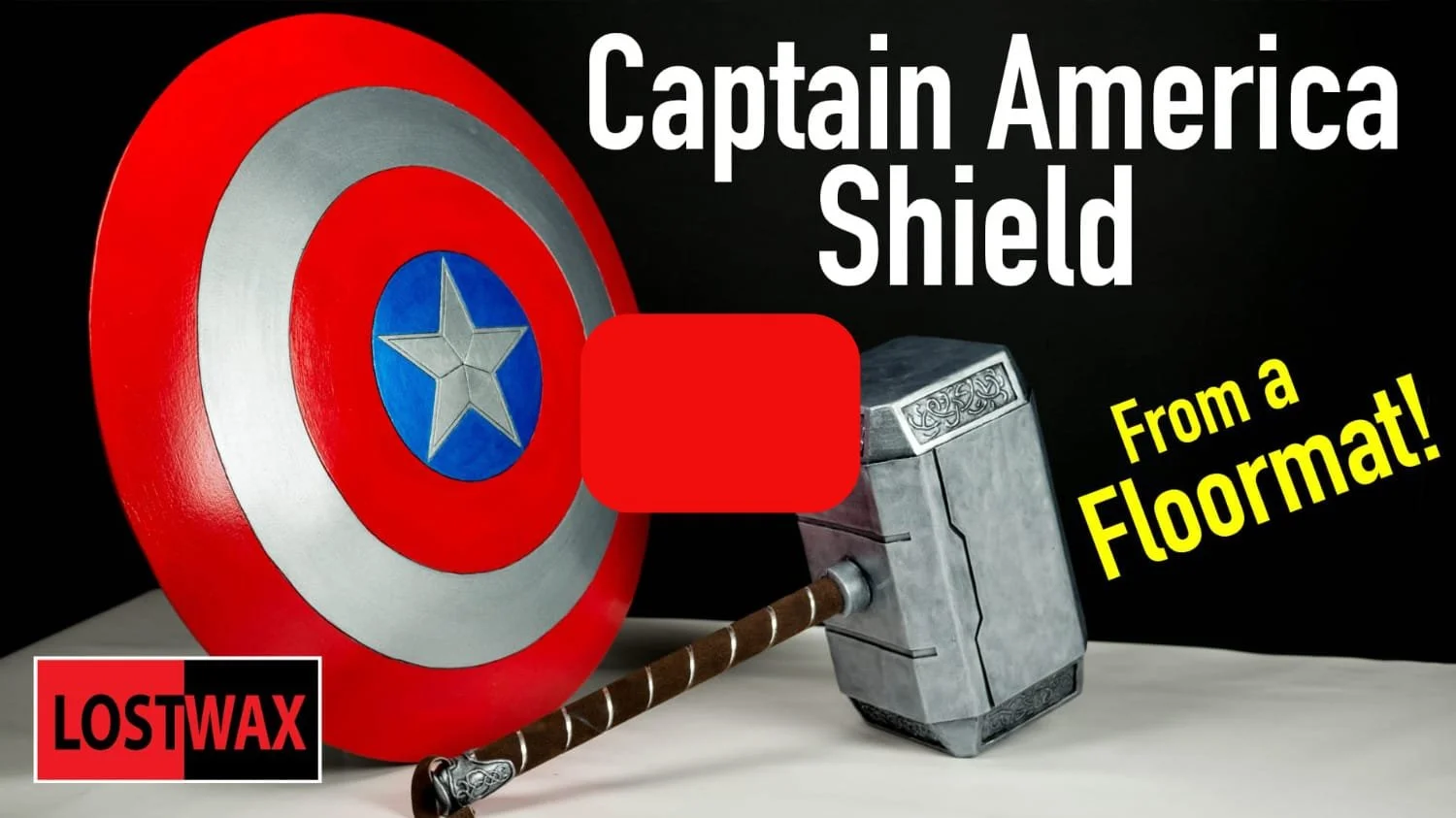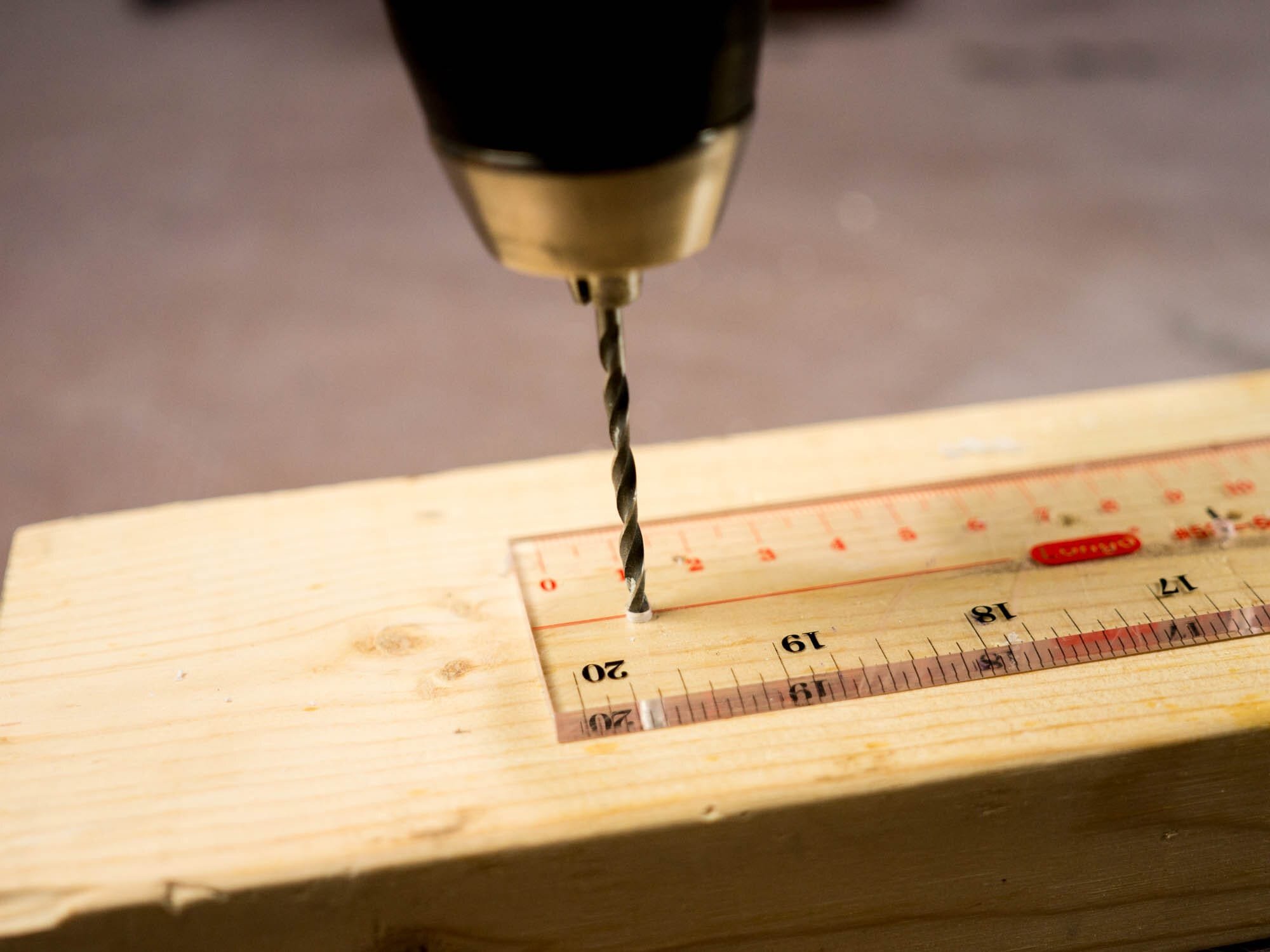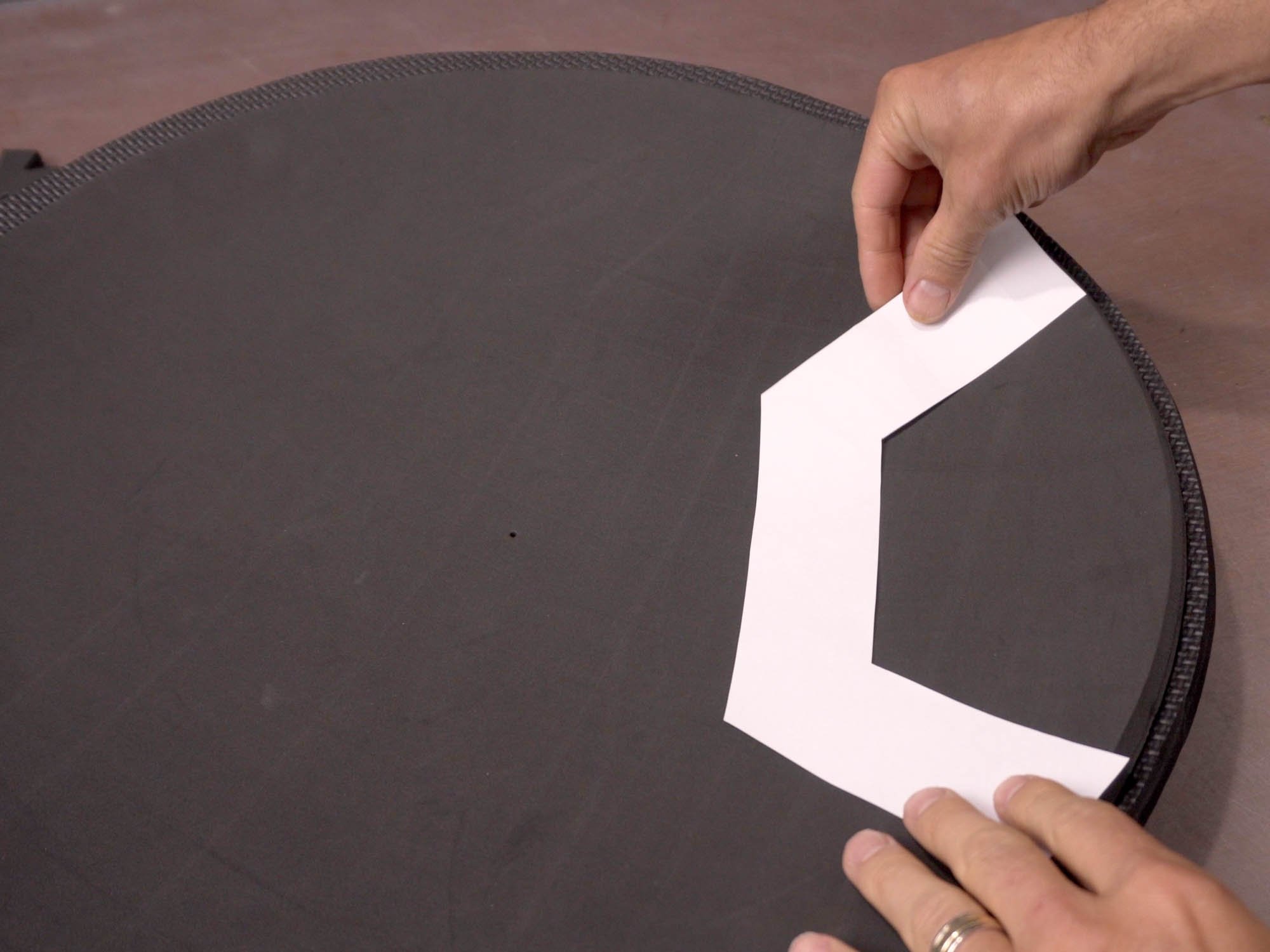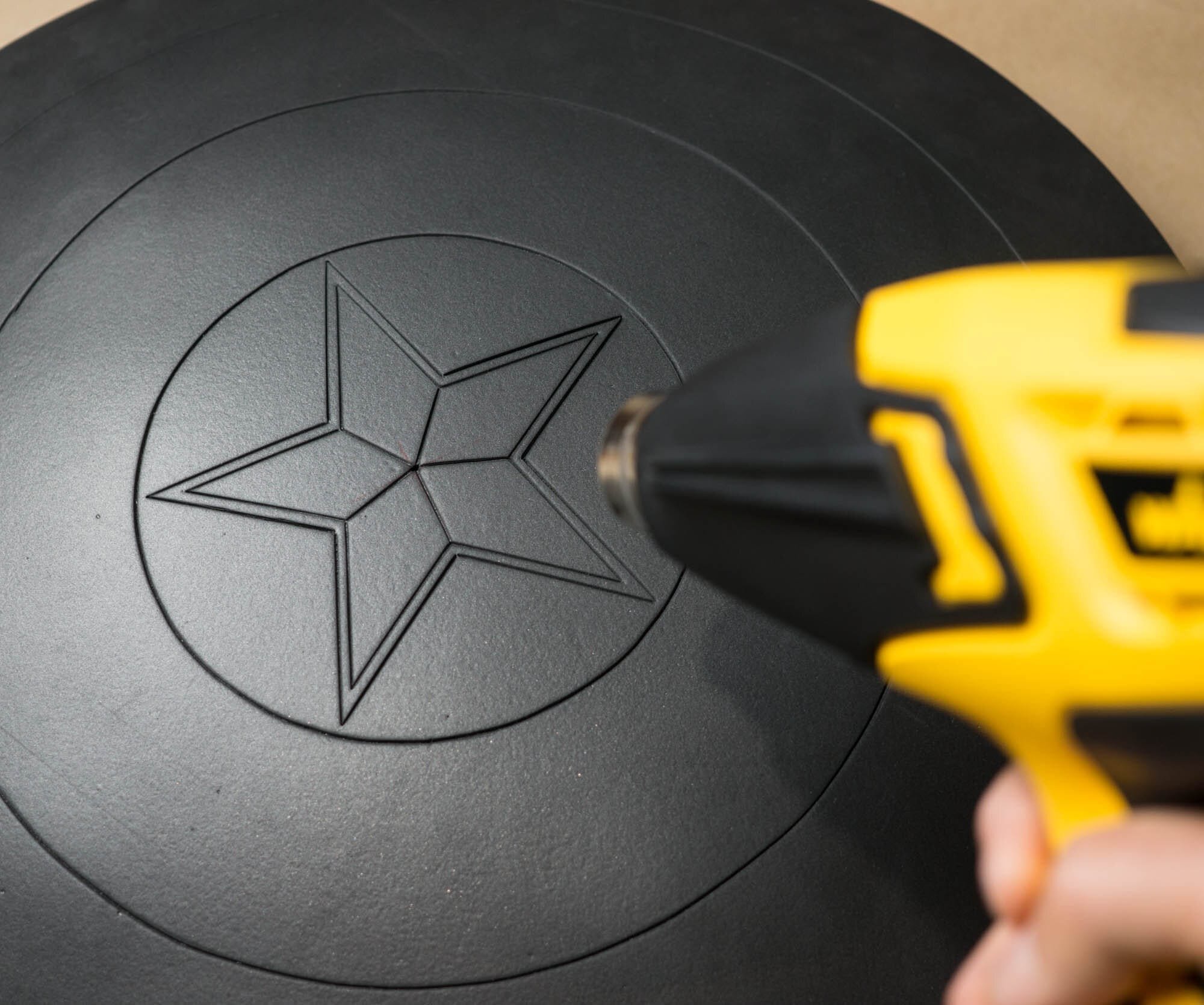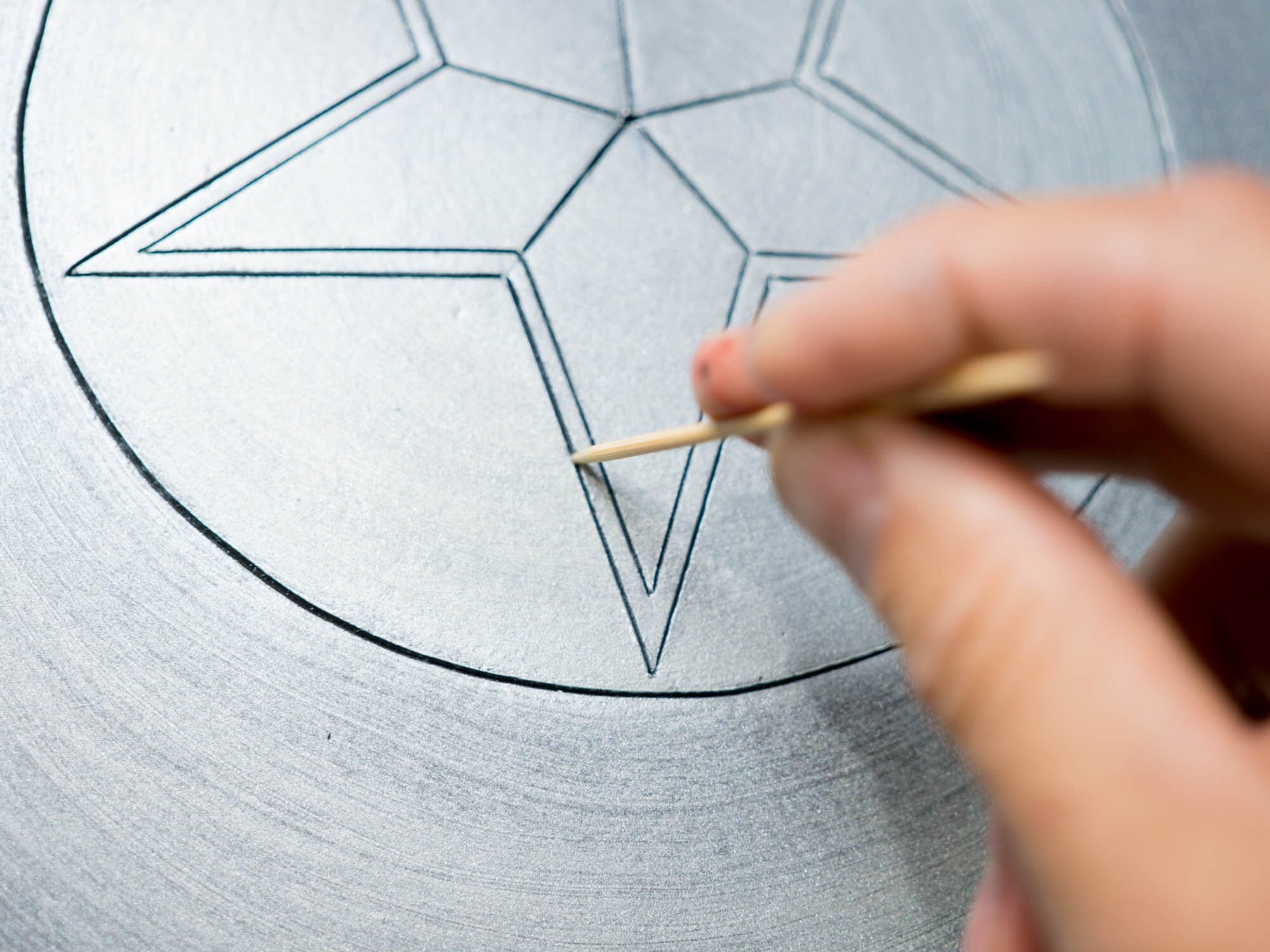How to Make a Captain America Shield from Foam
A while ago I pioneered a way of doming EVA foam floor-mats that required the use of a hot car to "bake" the foam into shape. (You can find that technique here) As I am keenly aware, living in Canada, not everyone has access to a hot car when they really need it, so I decided to try again, inside a normal temperature house. :) I figured this time I'd make a Captain America shield.
Here are the tools and materials I used:
Templates: I created a star template and one for the back plate. You can find them for free in my pattern shop.
Metre stick
Ruler
Pen
Drill Bits
BBQ Skewer
Exercise Ball
Clear Packing Tape
2 Part 5 Minute Epoxy
Sharp Knife: If it is not really sharp you will have a terrible time when you are cutting the foam
Hot Glue Gun: I highly suggest a glue gun that has adjustable temperature. If you use a temperature just a little bit higher than the melting point of the glue, you will have fewer burnt fingers, and not have to hold pieces together as long as they cool.
Contact Cement: I used water based contact cement because it is less toxic to breathe than regular contact cement
Old Belt
Paint: I like to use artists acrylic paint. It tends to remain a little bit flexible when it dries.I used DecoArt Americana Decor Metallics Silver for the background.
Heat Gun : I used the Furno 700 which was provided to me by Wagner for opening score lines and forming the foam
Cling wrap
Respirator: It is important not to breathe the fumes from the foam when it is heated
It’s also really helpful to watch my tutorial video (and there’s a sweet intro you won’t want to miss!):
Now on to the Captain America shield tutorial…
Step 1: Find the Centre of Your Floor Mat
Finding the center of the foam exercise mat
Use a long ruler or metrestick/yardstick to find the center of one of the 10mm thick puzzle piece foam mats.
Place it diagonally across the mat and make a short line at around the halfway mark.
Turn it diagonally the other direction and make another line that will cross the first line. The point where they cross should be very close to the center of the mat.
**Handy Tip** I found that the ink in the fine marker I used bled through the paint layer. It would be a great idea to use some rubbing alcohol, or whatever works for the ink you are using, and remove your pen lines before painting.
Step 2: Make a Fancy Tool
Ruler marked at different lengths
Drilling holes in the ruler
Make marks with a pen at the 1cm, 9cm, 15.5cm, 22cm, 27cm, and 29cm marks on your ruler.
Drill a hole at each mark down the center of the ruler.
Finished tool for making circles
Choose a drill bit that will make a hole that is just large enough so that when you stick the pen through it, the tip of the pen will stick out the other side of the ruler just a little bit.
You want to be able to fit your bbq skewer right through the hole at the 1cm mark, so, depending on the size of your bbq skewer, you may need to drill that hole a little larger.
Step 3: Draw Some Circles (with a Little Help From a Fancy Tool)
Stack the two foam mats on top of each other and line them up perfectly.
Check that the center mark you made on your foam mat is actually in the centre by placing the 1cm hole right on the center mark and then making sure that the outside (29cm) hole doesn't go off any of the edges.
Once you have verified the center, use your skewer to pierce through the 1cm mark on the ruler and through both foam sheets at the center.
Place your pen in each of the drilled holes except the 27cm hole. (and of course, the 1cm hole that has a skewer through it) and spin the ruler/pen combo around the center skewer, marking 4 concentric circles on the top sheet of foam.
Switch the foam sheets, so the second one is on top, replace the skewer/ruler tool, and make a circle using the 27cm hole.
Step 4: Cut Some Circles
Cutting with knife angled to make the smaller disc.
Small disc on top of larger one.
Make sure you have a sharp blade in your knife. You can do a test cut on one of the corners of the foam sheet, and if the cut isn't nice and smooth, you need a new blade.
On the foam mat with the concentric circles, cut on the outside line, keeping your knife blade nice and square to the surface. I find it works better to do 2 or 3 cuts along the same line rather than trying to cut all the way through the foam in one pass.
Now cut out the disc from the second sheet of foam (the one marked on the 27cm mark). This time while you are cutting around the disc, angle the knife blade so that it cuts at an outward angle as you go.
This should give you two foam discs, one slightly larger than the other.
Step 5: Score!
Scoring the circles on the shield.
Heat up the score marks to make them spread.
On the larger disc, score along the other marked circles with your sharp knife, but cut them only about 1mm deep.
Take the foam outside for airflow and wear a respirator to protect yourself from fumes.
Using a heat gun, apply heat to the score lines, which will open them up and create nice grooves around the shield.
You can also use the heat gun to heat seal the foam so that later on, you won't need to use quite as much paint. You can tell when it is sealed because it turns a bit shinier when you heat it.
Step 6: Go Crazy With Cling Wrap
Wrapping the shield onto the exercise ball with clingwrap.
Now it is time to try and form this flat sheet of foam into a nice even dome shape.
Grab your cling wrap and start by wrapping once around the ball, holding the larger foam disc against the ball, with the smooth side (the side with the concentric circles) facing out. Once it is held in place, take the smaller circle and wrap it onto the other side of the ball with the textured side facing out.
Extra care given to the edges that don’t want to be smooth.
Now continue to wrap the cling wrap around the foam discs and ball, pulling the cling wrap quite tightly as you go. Wherever there is an edge of foam that is lifting away from the ball, press the lifted part down as you go over that section with the cling wrap. You don't need to use a continuous strip of cling wrap, I found that shorter strips worked well, as I was able to target the areas that needed further attention. By the time you are finished, the ball and foam should be completely covered with 2-3 layers of cling wrap.
Step 7: Tape It Good
Adding packing tape around the edges.
Use strips of packing tape to reinforce the cling wrap.
Using the packing tape, apply strips around the outside perimeter of each foam disc. You are not trying to go around the edge with one long strip of tape, but rather, keep each strip of tape straight and run it from the ball, up over an edge of the foam and then back down onto the ball again. Overlap the strips as you go.
Step 8: Heat It Up
Use a heat gun to slowly heat up the foam.
The goal here is to have the foam heat up all the way through, so just blasting the outside with a quick shot of hot air is not going to be enough. I set my heat gun to 800 degrees F and spent 13 minutes heating up each disc of foam.
It is important to keep the heat gun moving so that you don't melt through the cling wrap.
Normally I don't advise people to heat foam inside because of the potential gasses that can be released, but I figured that the cling wrap was creating a good seal against the foam and so there wasn't a lot of danger. (use your own discretion of course!)
Once I had heated both foam discs, I let the ball sit overnight to let everything cool down and stay in position.
Step 9: Release the Foam!
Once the foam has set overnight, it's time to set it free!
Cut off the tape and cling wrap with a pair of scissors, being careful not to puncture the ball.
You should have two nicely formed foam domes! Sweet!
Step 10: Back Handles
Pattern for handle details
Making marks for the handle slots.
I didn't try to make the handles on the back of the shield too screen accurate, but I did make a template for the two pieces that are riveted to the back of the shield.
Cut two of those pieces from 2mm thick craft foam and hot glue them down to the back of the shield on opposite sides.
Make marks for two slots on each back piece, the width of the old belt that will make up the handles.
Cut the slots with a sharp knife.
Step 11: Add Some Handles
Figure out how long the handle should be
Glue the handles to the back, after pushing them through the slots.
Insert the belt through the slots and determine how long you would like the handles to be. I like one handle to be a bit longer than the other so that it can fit over my arm while I hold the other handle.
With the belt sticking through the slots, cut it off so that there is about 5cm protruding on each end.
Sand the belt and the foam where it is going to be glued down and then fold over the belt ends and glue them with hot glue.
** For the smoothest shield possible, it is a good idea to cut some shallow recesses where the belts are glued to the foam. That way the belts can sit flush with the foam and you won't get any surprise bulges when you glue the two halves together. I forgot to do this on my shield and I wish I had.
Step 12: The Two Become One
Painting water based contact cement onto the textured side.
The front and back of the shield, waiting for the glue to dry.
Spread contact cement on the textured sides of both shield parts, and follow the instructions on the contact cement as far as drying time.
Once ready, use some cardboard strips to keep the two halves from touching each other as you line them up perfectly centred on top of each other.
As you press the two pieces together, pull out the cardboard strips, allowing the contact cement to grip.
Press the two pieces firmly together so that the contact cement can create a good bond.
Gluing the two pieces together "locks" the done shape into the foam, making it stay that way long term.
Step 13: Make Some Fake Rivets
Using a match to apply dots of epoxy to make rivets.
There are a few ways to make fake rivets. You can use small google eyes, foam discs, or my favourite: 5 minute epoxy.
The thing I like about epoxy rivets is that they don’t all look the same, which gives a better simulation of something hand made in the past. They also don’t jiggle like the google eyes do.
Using 2 part 5 minute epoxy, squeeze out equal parts and mix them thoroughly. You only want a very small amount of epoxy as it will start to harden in a few minutes.
Dip the head of a wooden match or something similar into the epoxy and lightly touch it against the place where you want your rivet. Slowly lift the match head away, leaving behind a small blob of epoxy. As the epoxy cures it will get thicker until it is leaving long strings behind when you make your dots. This means it is time to make another little batch of epoxy.
As you are working, stay aware of how you are holding the pieces and that you aren’t touching rivets that aren’t fully cured.
Step 14: Superstar
Make a star template (or use mine) that fits in the centre of the shield.
Mark all the points with a pin and then use a ruler and knife to score the lines between the pin holes.
Use a heat gun to open up the score lines.
Step 15: Paint It... Vibranium.
It is always hard to make non-metallic things look metallic, but I wanted to get as much of the look of spun metal as I could, just using paint over foam.
I used silver metallic paint as a base coat. I tried to apply the paint following the curve of the lines. Once I had painted one of the rings, I would go over the ring with a coarse paintbrush, trying to cover the whole thing in a continuous spiral to create the ridged texture of spun metal.
If you find paint getting into the lines of the design, just use a barbecue skewer or similar tool to clean out the paint.
Step 16: All Done!
Thanks for hanging out with me!
If you'd like to see more of my projects you can find me here:
Subscribe to my YouTube Channel
Follow me on Instagram
Check out my Pattern Shop

